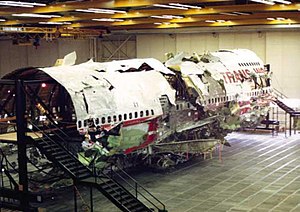
- Image via Wikipedia
Our coverage of the Air France flight continues. We do not believe in speculation during such a serious situation, but intend to keep our readers updated.
At this point, the plane has been missing for over twenty four hours. Four hours into the flight, and well over the ocean, the flight encountered heavy turbulence. It was already passed radar coverage. Fifteen minutes later, it transmitted its automated alert messages indicating a serious failure.
Some are predicting weather and lightning may have played a role in the downing of an aircraft. If so, it would be the first crash attributed to lightning since a Pan Am 707 exploded over Maryland in 1963 after lightning ignited fuel fumes. If it was weather, no airliner at cruising altitude has been brought down by weather since a BOAC 707 crashed in Japan in 1966. Aircraft contain radar to avoid severe storms.
Industry investigators are looking into the aircraft, the Airbus 330-200, for any possible clues in explaining the mystery. The Airbus 330 has a good safety record, this being its first crash on record, excluding a crash during initial testing by the manufacturer in 1994. The plane in question was just over four years old and was fully checked out in April.
Finding the plane now is going to be a challenge. “If an airplane went down in the mid-Atlantic, it could be very difficult to find any physical wreckage,” said John Hansman, a professor of aeronautics and astronautics at the Massachusetts Institute of Technology. “The mid-oceans are one of the remotest parts of the world. It’s like going to the North Pole. It’s in an area of where there is very limited ability to communicate.”
Airplane black boxes have beacons that activate when wet. The signal works for about a month, and the teams will have to be within 4000 to 5000 feet to pick up the signal…a challenge as they have not found any sign of wreckage yet, and it could be spread out over a large distance at this point. While new technologies such as GPS satellite tracking could have provided a more accurate minute-by-minute update on the planes location, not all planes are equipped, and there is no requirement for them to be.
There is hope, however. In 1999, Egyptair Flight 990 crashed off the coast of Nantucket. The debris sank in nearly 300 feet of water, a storm soon whipped seas as high as 22 feet and conditions were described as pitch black. Diving gear, sonar, and other precision equipment continue to improve in quality. During that retrieval, the flight recorders off of the Egyptair flight were found and used to determine a probable cause of the crash. In the case of TWA Flight 800, which also crashed near the coast, much of the plane was reconstructed. In the Egyptair crash, despite the conditions, grieving relatives complained that bodies were not brought to the surface immediately. These things take time. In the case of one missing plane…over 50 years before it was found.
Of course, this is a much wider search area, but once it is narrowed down, the experts will move in to salvage the remains. The information will be investigated by the best available people. The answer will not bring the victims back, but we can try to use what we learn to ensure that such tragedies do not happen again.
Related articles by Zemanta
- Hopes fade for missing jet survivors (cnn.com)
- Air France plane lost: the Airbus 330200 (telegraph.co.uk)
- ‘No hope’ of survivors after Air France flight disappears (guardian.co.uk)
- You: Air France Jet Disappears on Flight From Brazil to Paris (nytimes.com)
![Reblog this post [with Zemanta]](http://img.zemanta.com/reblog_e.png?x-id=94664b7b-83d2-42fb-9ad0-7e3f5d2fe234)